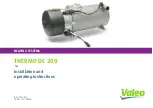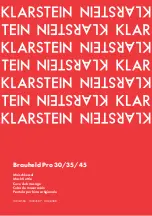
EasyWeld / HandyWeld 160
STICK (MMAW) Welding 6-4 0-5617
6.07 Effects of Arc Welding Various
Materials
A. High tensile and alloy steels
The two most prominent effects of welding these
steels are the formation of a hardened zone in the
weld area, and, if suitable precautions are not taken,
the occurrence in this zone of under-bead cracks
may result. Hardened zone and under-bead cracks in
the weld area may be reduced by using the correct
electrodes, preheating, using higher current settings,
using larger electrodes sizes, short runs for larger
electrode deposits or tempering in a furnace.
B. Austenitic manganese steels
The effect on manganese steel of slow cooling from
high temperatures is to embrittle it. For this reason it
is absolutely essential to keep manganese steel cool
during welding by quenching after each weld or skip
welding to distribute the heat.
C. Cast Iron
Most types of cast iron, except white iron, are weld-
able. White iron, because of its extreme brittleness,
generally cracks when attempts are made to weld
it. Trouble may also be experienced when welding
white-heart malleable, due to the porosity caused by
gas held in this type of iron.
D. Copper and alloys
The most important factor is the high rate of heat
conductivity of copper, making preheating of heavy
sections necessary to give proper fusion of weld and
base metal.
6.08 Arc Welding Practice
The techniques used for arc welding are almost
identical regardless of what types of metals are being
joined. Naturally enough, different types of electrodes
would be used for different metals as described in the
preceding section.
6.09 Welding Position
The electrodes dealt with in this publication can be
used in most positions, i.e. they are suitable for weld-
ing in flat, horizontal, vertical and overhead positions.
Numerous applications call for welds to be made in
positions intermediate between these. Some of the
common types of welds are shown in Figures 6-2
through 6-9.
Art # A-07687
Figure 6-2: Flat position, down hand butt weld
Art # A-07688
Figure 6-3: Flat position, gravity fillet weld
Art # A-07689
Figure 6-4: Horizontal position, butt weld
Art # A-07690
Figure 6-5: Horizontal - Vertical (HV) position
Art A-07691
Figure 6-6: Vertical position, butt weld
Art # A-07692
Figure 6-7: Vertical position, fillet weld
Summary of Contents for Cigweld EasyWeld 160
Page 8: ...This Page Intentionally Blank ...
Page 14: ...EasyWeld HandyWeld 160 GENERAL INFORMATION 1 6 0 5617 This Page Intentionally Blank ...
Page 26: ...EasyWeld HandyWeld 160 INSTALLATION 3 4 0 5617 This Page Intentionally Blank ...
Page 32: ...EasyWeld HandyWeld 160 OPERATION 4 6 0 5617 This Page Intentionally Blank ...
Page 56: ...MIG GMAW WELDING 5 24 Manual 0 5617 EasyWeld HandyWeld 160 This Page Intentionally Blank ...
Page 70: ...EasyWeld HandyWeld 160 STICK MMAW Welding 6 14 0 5617 This Page Intentionally Blank ...
Page 78: ...KEY SPARE PARTS 8 4 0 5617 EasyWeld HandyWeld 160 This Page Intentionally Blank ...
Page 80: ...EasyWeld HandyWeld 160 APPENDIX A 2 0 5617 This Page Intentionally Blank ...
Page 83: ...EasyWeld HandyWeld 160 This Page Intentionally Blank ...
















































